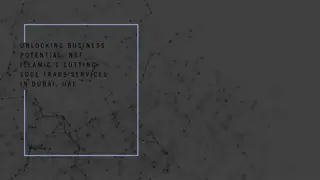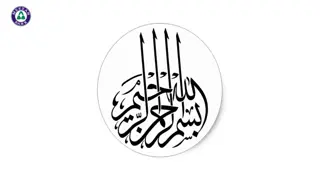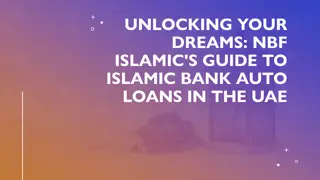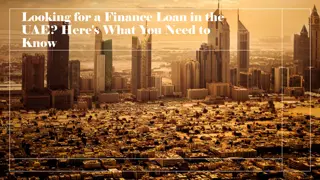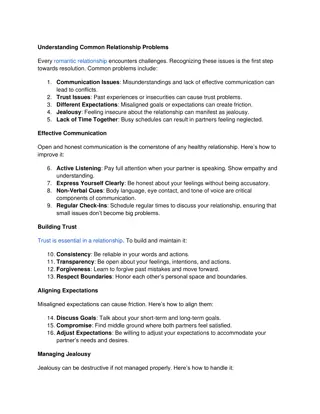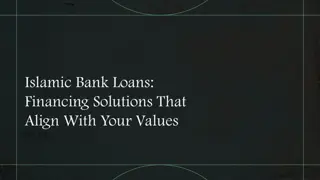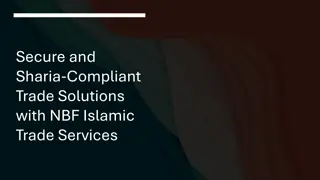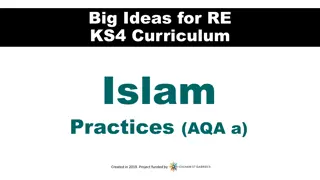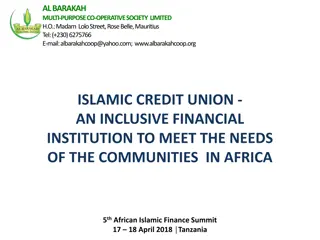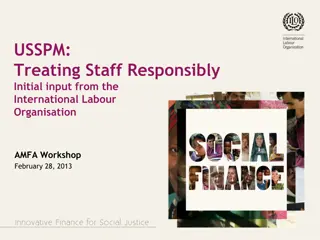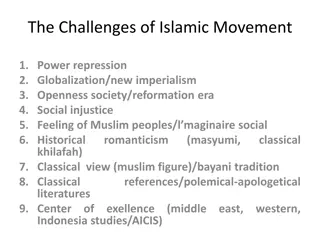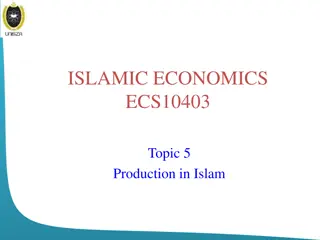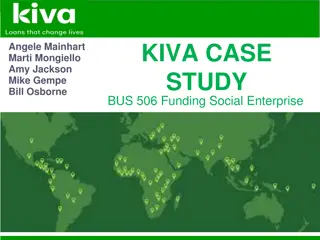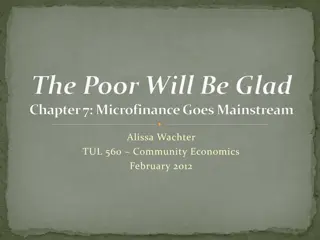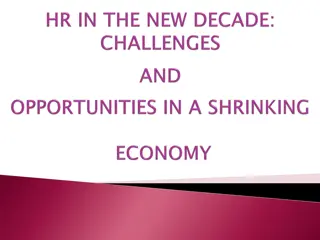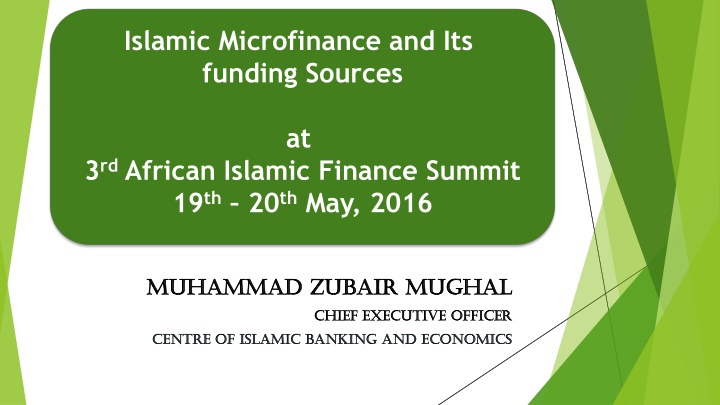
Islamic Microfinance Funding Sources and Opportunities
Learn about the importance of Islamic microfinance, its sources of funding, and the benefits it offers in promoting financial inclusion and poverty alleviation. Explore the comparison with conventional microfinance models, factors to consider in Islamic finance, and the sustainability of Sharia-compliant funds. Discover how Islamic microfinance aligns with ethical and social values, benefiting both Muslim and non-Muslim communities in economic development.
Download Presentation

Please find below an Image/Link to download the presentation.
The content on the website is provided AS IS for your information and personal use only. It may not be sold, licensed, or shared on other websites without obtaining consent from the author. If you encounter any issues during the download, it is possible that the publisher has removed the file from their server.
You are allowed to download the files provided on this website for personal or commercial use, subject to the condition that they are used lawfully. All files are the property of their respective owners.
The content on the website is provided AS IS for your information and personal use only. It may not be sold, licensed, or shared on other websites without obtaining consent from the author.
E N D
Presentation Transcript
Islamic Microfinance and Its funding Sources at 3rd African Islamic Finance Summit 19th 20th May, 2016 Muhammad Muhammad Zubair Zubair Mughal Mughal Chief Executive Chief Executive Officer Officer Allhuda Allhuda centre of Islamic banking and economics centre of Islamic banking and economics
Contents Why Islamic Microfinance ? Source of Islamic Micro Finance Product Products Need Assessment of Islamic Microfinance Compatibility of IMF Products with Conventional Microfinance Models Funding Sources for Islamic Microfinance Institutions Opportunities & Challenges Faced by IMF Sector
Why Islamic Microfinance? Prohibition of Interest - Financial Inclusion. Care for the poor is a religious obligation in Islam. Asset Based Financing Approximately 44% conventional microfinance clients worldwide reside in Muslim countries Almost one-half of the 57 IDB member countries in Asia and Africa are classed as United Nations Least Developed Countries (LDCs) Sustainable Financial Solution for All. Higher Impact Compare to Conventional Microfinance Assisting the poor is a pillar of Islam
Source of Islamic Microfinance Products Islamic Banking & Microfinance Product Mechanism Sources of Islamic Micro Finance Quran Sunnah Ijma a (jurist consensus) Ijtihad & Qiyas (analogy)
Ideal Utilization of Islamic Microfinance Products MicroTakaful Salam, Istisna and other products Non-Poor Transitory Non-Poor Transitory Vulnerable Qarz-e-Hasan, Murabahah, Ijarah, Mudarabah Transitory Poor Zakat, Sadqa, Ushar Chronic Poor Extremely Poor 5
Factors to be considered while doing Islamic Finance Poverty Alleviation Element and more . Social Ethical Moral A Misconception removed Micro Takaful Free from Gharar Free from Interest Financing Islamic Microfinance is a system not the Religion, it can be utilized & operated by both Muslims and Non-Muslim Communities for Poverty Alleviation, Social & Economic Development. Islamic Micro Finance Shariah Compliant Funds Ensure Shariah Compliance Trainings & Quality HR Shariah Vetted Products Shariah Compliant Investments
Compatibility IMF Products with MF Models Grameen Model: Village Bank Model: Sanadiq program -Jabal al-Hoss, Syria, FINCA - Afghanistan etc. Credit Union Model: Muslim Credit Union (Tobago), The Amwal Credit Union etc. Cooperative Model: AlBaraka MPCS Mauritius, Al- Khair Coop. India, Muslim Community Coop. Australia, Karakorum Cooperative Bank Pakistan. Self-Help Group: AameenSociety - India Amna Iftikhar Malaysia, Islami Bank Bangladesh Limited etc. For Profit Banks/MFIsGhana Islamic Microfinance Banks Ghana, HSBC Amanah U.K,
Current Status of Islamic Finance Industry 300+ Islamic Microfinance Institutions operating in 32 Countries USD 1 billion Market Size. Indonesia, Bangladesh, Pakistan and Afghanistan have 80% share of Global Islamic MF industry (CGAP) 2 Million+ Active financing Clients. Murabahah & Qarz-e-Hasan are the Major Products. Share of Islamic Microfinance in Islamic Finance industry & Microfinance Industry is less than 1%
Islamic Microfinance Institution Worldwide Germany:2 - Muslim Society Switzerland : 2 UAE: 4 - Dubai Islamic Bank - Abu Dhabi Islamic Bank - HSBC Amanah Kuwait: 2 - Kuwait Finance House UK: 5 - HSBC Amanah - Muslim Aid - Islamic Relief Faith Matters - The Halal Mutual Investment Company United States: 3 Helping Hands ISNA Lariba Bahrain: 2 Family Bank Afghanistan 9: - FINCA , WOCCU - CHF Ariana Pakistan: 11 India: 3 Bangladesh:9 Iran: 8 Turkey: 2 - Faisal Finance Institution - Ikhlas Finance House Egypt: 3 - Alwatany Bank of Egypt - Egyptian Saudi Finance Sudan: 13 Malaysia: 11 2 - Pure Islamic Banks (Bank Islam, Bank Muamalat) Rest - banks Yemen: 05 Al- Amal Al Kuraimi South Africa Awqaf SA Indonesia: 133 BPRS , BMT. IMFI s Worldwide: 300 * in Countries: 32 Market Size: 1 billion USD+ Muaritius AlBaraka MPCS
Social Sukuk Generally Sukuk is utilized in the corporate sector for raising the funds for long term financing projects usually utilized for mega projects A new term Social Sukuk can be devised for such sukuk which is issued for social development and poverty alleviation projects.
Crowd Funding Technological Platform Crowd fund platform concept is emerging rapidly and now many IMFI s are utilizing this concept to secure the fund for Islamic Microfinance. AlHuda Center of Islamic Banking and Economics (CIBE) has also established a crowd funding system which is available to integrate with any Islamic Microfinance institution.
Venture Capital and Equity Financing: Venture Capital is usually utilized to start up, Islamic Microfinance Institutions can also be developed through venture capital in Shariah Compliant manners Islamic Microfinance institutions can raise their funds through Equity Financing or Venture capital by utilizing Mudaraba or Musharaka mechanism. Shariah compliant equity fund is also available in Islamic financial industry which is an motivational factor to introduce a equity fund for the development of Islamic Microfinance industry which facing problem of funding.
Donor Grants, Soft Loans (Qarz-e-Hassan) & Govt. Subsidies Donor Grants, Soft loans and Govt. Subsidies play a vital role for the development of Microfinance sector, but unfortunately, it is observed that International donor agencies are bit reluctant for Islamic Microfinance Multilateral donor agencies are taking interest for the promotion of Islamic Microfinance as tool of financial inclusion and social development like Islamic Development Bank, GIZ, USAID, UKAID, IFAD and other agencies. Recently, the Govt. of Pakistan provides Qarz-e-Hassan (Soft Loans) to Islamic Microfinance institutions as well
Less Commercial Approach in Islamic Banking Unfortunately, Islamic Microfinance have less than 1% in Islamic finance industry, which is a big question mark as well in Islamic finance that why Islamic Microfinance have less than 1% share in it Islamic Banking 78% Takaful 3% Sukuk 14% Islamic Finance Market Size: US $ 2 trillion Islamic Microfina nce 1% Islamic Funds 4%
Charity Funds of Islamic Banks & Financial Institutions The charity amount as collected by Islamic Banks and Financial institutions all over the world consists of huge amount which is utilized in different charitable purposes but did not utilized in Islamic Microfinance to address the funding need of IMFIs, so it would be the ideal source for Islamic Microfinance institutions as well.
Musharaka Model for Islamic Microfinance Institution
Challenges faced by Islamic Microfinance Non - Availability of Donor/Shariah Compliant Sources of Funds Need to develop a uniform regulatory and legal framework for the Islamic Microfinance Institutions. Accounting & I.T systems., Rating Agencies. Lack of Quality HR in Islamic Microfinance Sector. Standardization of Islamic Microfinance Products. Reluctance in Research & Implementation of new Products, as only (Murabahah) is serving almost 80% of Islamic Microfinance Industry. Development of Shairah Expertise towards the Growth of Islamic Microfinance. Policies & Regulations on Zakat & Awqaf.
Opportunities for Islamic Microfinance Islamic Microfinance Network (IMFN) for an effective interface and Coordination among IMFI s Expansion of Market where the Conventional MFI s face limitations especially in Muslim Majority Countries AlHuda Centre of Excellence in Islamic Microfinance is offering all Islamic Microfinance Solution. A Trend in diversion of donors funds to more ethical objectives IDB - Microfinance Development Program (MDP ) Islamic Banking and Finance is emerging in South Asia, Central Asia & MENA region which will strengthened the Islamic Microfinance effectively.
JazzakAllah Thank you for listening Zubair.mughal@alhudacibe.com www.alhudacibe.com

